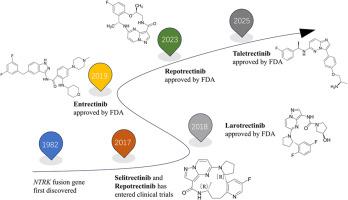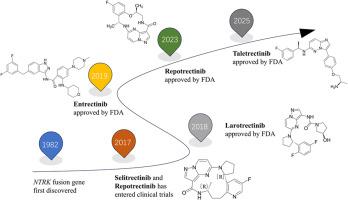TRK抑制剂及其构效关系的研究进展
IF 5.9
2区 医学
Q1 CHEMISTRY, MEDICINAL
引用次数: 0
摘要
神经营养型酪氨酸受体激酶(NTRK)是跨膜受体酪氨酸激酶家族的一员。TRK蛋白维持神经细胞的存活和正常运作,与细胞分裂、增殖、代谢和凋亡密切相关。NTRK基因与其他基因的任何融合突变都会导致TRK蛋白异常,从而导致细胞分裂异常,促进恶性肿瘤的发展。由于NTRK是第一个被发现的与癌症无关的可药物基因,它无疑是世界上最重要的抗癌靶点之一。然而,NTRK基因融合在不到1%的实体瘤中发生,但在罕见肿瘤中非常常见,这表明早期诊断很困难。同时,由于靶向或脱靶耐药的机制,患者在治疗后对TRK抑制剂产生耐药,疗效大大降低,因此有必要进行进一步的研究以克服耐药问题。为了为开发更安全、更有效的NTRK靶向抑制剂提供理论基础,扩大NTRK基因融合患者的治疗选择范围,本文综述了基因融合的机制和特点,以及已上市和正在研究的靶向治疗药物的研究现状。本文章由计算机程序翻译,如有差异,请以英文原文为准。


Research progress of TRK inhibitors and their structure-activity relationship
Neurotrophic tyrosine receptor kinase (NTRK) is a member of the transmembrane receptor tyrosine kinase family. The TRK protein preserves the survival and regular operation of nerve cells and is intimately linked to cell division, proliferation, metabolism, and apoptosis. Any fusion mutations in the NTRK gene with other genes will result in aberrant TRK protein, which causes aberrant cell division and promotes the development of malignancies. As NTRK is the first identified cancer-independent and druggable gene, it is undoubtedly one of the most important anti-cancer targets in the world. However, NTRK gene fusions occur in less than 1 % of solid tumors but are very common in rare tumors, suggesting that early diagnosis is difficult. At the same time, due to the mechanism of targeted or off-target drug resistance, patients become resistant to TRK inhibitors after treatment, and the efficacy is greatly reduced, so it is necessary to conduct further research to overcome the drug resistance problem. In order to provide a theoretical foundation for the development of safer and more effective inhibitors against this target and to expand the range of treatment options available to patients with NTRK gene fusion, this article reviews the mechanism and characteristics of gene fusions, as well as the research status of marketed and investigational targeted therapy drugs.
求助全文
通过发布文献求助,成功后即可免费获取论文全文。
去求助
来源期刊
CiteScore
11.70
自引率
9.00%
发文量
863
审稿时长
29 days
期刊介绍:
The European Journal of Medicinal Chemistry is a global journal that publishes studies on all aspects of medicinal chemistry. It provides a medium for publication of original papers and also welcomes critical review papers.
A typical paper would report on the organic synthesis, characterization and pharmacological evaluation of compounds. Other topics of interest are drug design, QSAR, molecular modeling, drug-receptor interactions, molecular aspects of drug metabolism, prodrug synthesis and drug targeting. The journal expects manuscripts to present the rational for a study, provide insight into the design of compounds or understanding of mechanism, or clarify the targets.

 求助内容:
求助内容: 应助结果提醒方式:
应助结果提醒方式:


